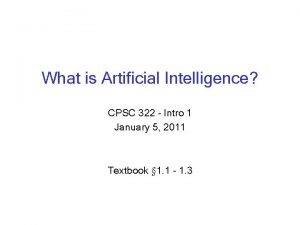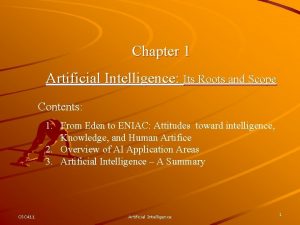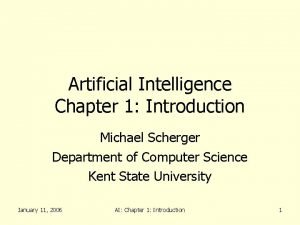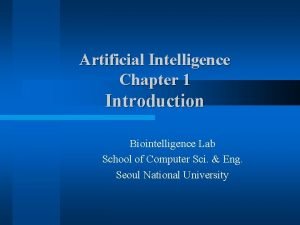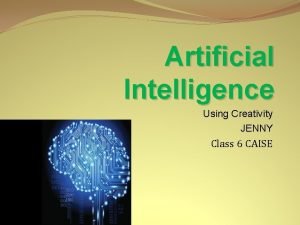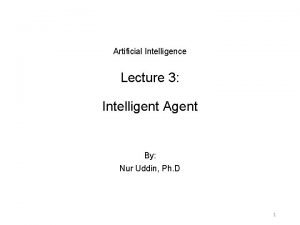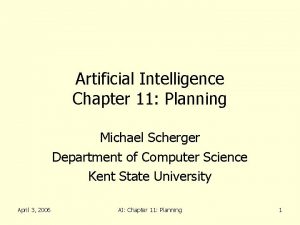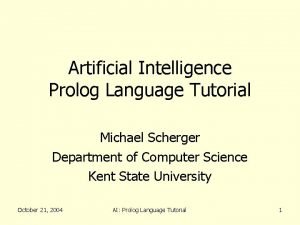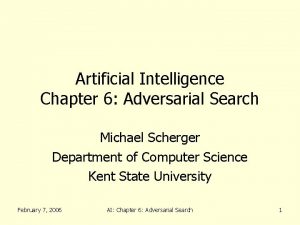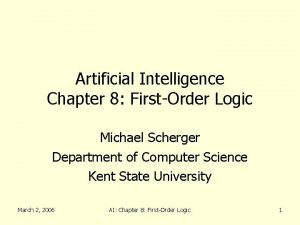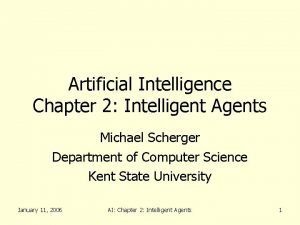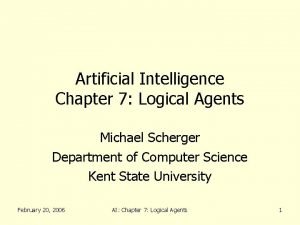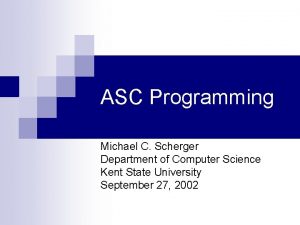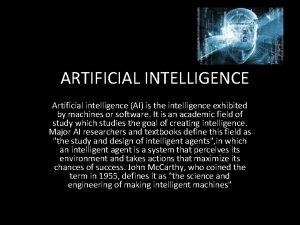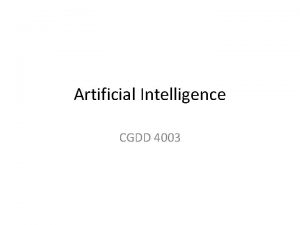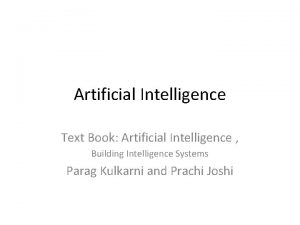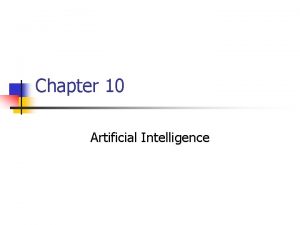Artificial Intelligence Chapter 1 Introduction Michael Scherger Department






























- Slides: 30

Artificial Intelligence Chapter 1: Introduction Michael Scherger Department of Computer Science Kent State University January 11, 2006 AI: Chapter 1: Introduction 1

What is Intelligence? • Main Entry: in·tel·li·gence Pronunciation: in-'te-l&-j&n(t)s Function: noun Etymology: Middle English, from Middle French, from Latin intelligentia, from intelligent-, intelligens intelligent • 1 a (1) : the ability to learn or understand or to deal with new or trying situations : REASON; also : the skilled use of reason (2) : the ability to apply knowledge to manipulate one's environment or to think abstractly as measured by objective criteria (as tests) b Christian Science : the basic eternal quality of divine Mind c : mental acuteness : SHREWDNESS • 2 a : an intelligent entity; especially : ANGEL b : intelligent minds or mind <cosmic intelligence> • 3 : the act of understanding : COMPREHENSION • 4 a : INFORMATION, NEWS b : information concerning an enemy or possible enemy or an area; also : an agency engaged in obtaining such information • 5 : the ability to perform computer functions January 11, 2006 AI: Chapter 1: Introduction 2

A Bit of Humor January 11, 2006 AI: Chapter 1: Introduction 3

Goals of this Course • Become familiar with AI techniques, including their implementations – Be able to develop AI applications • Python, Li. SP, Prolog, CLIPS • Understand theory behind the techniques, knowing which techniques to apply when (and why) • Become familiar with a range of applications of AI, including “classic” and current systems. January 11, 2006 AI: Chapter 1: Introduction 4

What is Artificial Intelligence? • Not just studying intelligent systems, but building them… • Psychological approach: an intelligent system is a model of human intelligence • Engineering approach: an intelligent system solves a sufficiently difficult problem in a generalizable way January 11, 2006 AI: Chapter 1: Introduction 5

A Bit of AI History (section 1. 3) • Gestation (1943 -1955) – Early learning theory, first neural network, Turing test – Mc. Culloch and Pitts artificial neuron, Hebbian learning • Birth (1956) – Name coined by Mc. Carthy – Workshop at Dartmouth • Early enthusiasm, great expectations (1952 -1969) – GPS, physical symbol system hypothesis – Geometry Theorem Prover (Gelertner), Checkers (Samuels) – Lisp (Mc. Carthy), Theorem Proving (Mc. Carthy), Microworlds (Minsky et. al. ) – “neat” (Mc. Carthy @ Stanford) vs. “scruffy” (Minsky @ MIT) January 11, 2006 AI: Chapter 1: Introduction 6

A Bit of AI History (section 1. 3) • Dose of Reality (1966 -1973) – Combinatorial explosion • Knowledge-based systems (1969 -1979) • AI Becomes an Industry (1980 -present) – Boom period 1980 -88, then AI Winter • Return of Neural Networks (1986 -present) • AI Becomes a Science (1987 -present) – SOAR, Internet as a domain January 11, 2006 AI: Chapter 1: Introduction 7

What is Artificial Intelligence? (again) • Systems that think like humans • Systems that think rationally • Systems that act like humans • Systems that act rationally – Cognitive Modeling Approach – “The automation of activities that we associate with human thinking. . . ” – Bellman 1978 – Turing Test Approach – “The art of creating machines that perform functions that require intelligence when performed by people” – Kurzweil 1990 January 11, 2006 – “Laws of Thought” approach – “The study of mental faculties through the use of computational models” – Charniak and Mc. Dermott – Rational Agent Approach – “The branch of CS that is concerned with the automation of intelligent behavior” – Lugar and Stubblefield AI: Chapter 1: Introduction 8

Acting Humanly • The Turing Test (1950) – Can machines think? – Can machines behave intelligently? • Operational test for intelligent behavior ? Human Interrogator – The Imitation Game January 11, 2006 Human AI: Chapter 1: Introduction AI System 9

Acting Humanly • Turing Test (cont) – Predicted that by 2000, a machine might have a 30% chance of fooling a lay person for 5 minutes – Anticipated all major arguments against AI in following 50 years – Suggested major components of AI: knowledge, reasoning, language understanding, learning • Problem! – The turning test is not reproducible, constructive, or amenable to mathematical analysis January 11, 2006 AI: Chapter 1: Introduction 10

Thinking Humanly • 1960’s cognitive revolution • Requires scientific theories of internal activities of the brain – What level of abstraction? “Knowledge” or “Circuits” – How to validate? • Predicting and testing behavior of human subjects (topdown) • Direct identification from neurological data (bottom-up) • Cognitive Science and Cognitive Neuroscience – Now distinct from AI January 11, 2006 AI: Chapter 1: Introduction 11

Thinking Rationally • Normative (or prescriptive) rather than descriptive • Aristotle: What are correct arguments / thought processes? • Logic notation and rules for derivation for thoughts • Problems: – Not all intelligent behavior is mediated by logical deliberation – What is the purpose of thinking? What thoughts should I have? January 11, 2006 AI: Chapter 1: Introduction 12

Acting Rationally • Rational behavior – Doing the right thing • What is the “right thing” – That which is expected to maximize goal achievement, given available information • We do many (“right”) things without thinking – Thinking should be in the service of rational action January 11, 2006 AI: Chapter 1: Introduction 13

Applied Areas of AI • • Heuristic Search Computer Vision Adversarial Search (Games) Fuzzy Logic Natural Language Processing Knowledge Representation Planning Learning January 11, 2006 AI: Chapter 1: Introduction 14

Examples • Playing chess • Driving on the highway • Mowing the lawn • Answering questions January 11, 2006 • • Recognizing speech Diagnosing diseases Translating languages Data mining AI: Chapter 1: Introduction 15

Heuristic Search • Very large search space – Large databases – Image sequences – Game playing • Algorithms – Guaranteed best answer – Can be slow – literally years • Heuristics – “Rules of thumb” – Very fast – Good answer likely, but not guaranteed! • Searching foreign intelligence for terrorist activity. January 11, 2006 AI: Chapter 1: Introduction 16

Computer Vision • Computationally taxing – Millions of bytes of data per frame – Thirty frames per second • Computers are scalar / Images are multidimensional • Image Enhancement vs. Image Understanding • Can you find the terrorist in this picture? January 11, 2006 AI: Chapter 1: Introduction 17

Adversarial Search • Game theory. . . – Two player, zero sum – checkers, chess, etc. • Minimax – My side is MAX – Opponent is MIN • Alpha-Beta – Evaluation function. . . ”how good is board” – Not reliable. . . play game (look ahead) as deep as possible and use minimax. – Select “best” backed up value. • Where will Al-Qaeda strike next? January 11, 2006 AI: Chapter 1: Introduction 18

Adversarial Search 1 X X O MIN O X 2 X X O MAX X X O O O X 3 4 X X O O O X X 1 -0=1 January 11, 2006 . . . 6 X 5 7 8 X X O O O X O O O X X X 1 -2=-1 X 1 -1=0 X *91* AI: Chapter 1: Introduction 9 X X 0 X X 10 19

Example: Tic Tac Toe #1 • Precompiled move table. • For each input board, a specific move (output board) • Perfect play, but is it AI? January 11, 2006 AI: Chapter 1: Introduction 20

Example: Tic Tac Toe #2 • Represent board as a magic square, one integer per square • If 3 of my pieces sum to 15, I win • Predefined strategy: – – – 1. 2. 3. 4. 5. Win Block Take center Take corner Take any open square January 11, 2006 AI: Chapter 1: Introduction 21

Example: Tic Tac Toe #3 • Given a board, consider all possible moves (future boards) and pick the best one • Look ahead (opponent’s best move, your best move…) until end of game • Functions needed: – Next move generator – Board evaluation function • Change these 2 functions (only) to play a different game! January 11, 2006 AI: Chapter 1: Introduction 22

Fuzzy Logic • Basic logic is binary – 0 or 1, true or false, black or white, on or off, etc. . . • But in the real world there are of “shades” – Light red or dark red – 0. 64756 • Membership functions January 11, 2006 AI: Chapter 1: Introduction 23

Fuzzy Logic Light Appetite Linguistic Variable Moderate Linguistic Values Heavy 1 Membership Grade 0 1000 2000 3000 Calories Eaten Per Day January 11, 2006 AI: Chapter 1: Introduction 24

Natural Language Processing • Speech recognition vs. natural language processing – NLP is after the words are recognized • Ninety/Ten Rule – Can do 90% of the translation with 10% time, but 10% work takes 90% time • Easy for restricted domains – Dilation – Automatic translation – Control your computer • Say “Enter” or “one” or “open” – Associative calculus • Understand by doing January 11, 2006 AI: Chapter 1: Introduction 25

Natural Language Processing Net for Basic Noun Group adjective “The big grey dog” S 1 determiner S 2 noun S 3 Net for Prepositional Group “by the table in the corner” S 1 preposition S 2 NOUNG S 3 Net for Basic Noun Group PREPG adjective “The big grey dog by the table in the corner” January 11, 2006 S 1 determiner S 2 AI: Chapter 1: Introduction noun S 3 26

Knowledge Representation • Predicate Logic – – On(table, lamp) In(corner, table) Near(table, dog) Prolog • Graph Based – Semantic Networks – Frames • Rule Based – Expert Systems January 11, 2006 AI: Chapter 1: Introduction 27

Planning • Robotics – If a robot enters a room and sits down, what is the “route”. Table • Closed world • Rule based systems • Blocks world January 11, 2006 AI: Chapter 1: Introduction Chair 28

Planning Robot Hand • Pickup(x) – Ontable(x), clear(x), handempty(), – Holding(x) C • Putdown(x) A – Holding(x) – Ontable(x), clear(x), handempty() B Clear(B) On(C, A) On. Table(A) Clear(C) Handempty On. Table(B) • Stack(x, y) – Holding(x), clear(y) – Handempty(), on(x, y), clear(x) • Unstack(x, y) B – Handempty(), clear(x), on(x, y) – Holding(x), clear(x) January 11, 2006 A AI: Chapter 1: Introduction C Goal: [On(B, C) ^ On(A, B)] 29

Learning • • Neural Networks Evolutionary Computing Knowledge in Learning Reinforcement Learning January 11, 2006 AI: Chapter 1: Introduction 30
 Pxdes
Pxdes Cpsc 322: introduction to artificial intelligence
Cpsc 322: introduction to artificial intelligence Cpsc 322 ubc
Cpsc 322 ubc Solving problems by searching artificial intelligence
Solving problems by searching artificial intelligence Artificial intelligence chapter 1
Artificial intelligence chapter 1 Artificial intelligence chapter 1
Artificial intelligence chapter 1 Artificial intelligence chapter 1
Artificial intelligence chapter 1 Architecture of expert system
Architecture of expert system Breadth first search prolog
Breadth first search prolog Searching for solutions in artificial intelligence
Searching for solutions in artificial intelligence 15-780 graduate artificial intelligence
15-780 graduate artificial intelligence Knowledge manipulation in ai
Knowledge manipulation in ai Types of knowledge in artificial intelligence
Types of knowledge in artificial intelligence Starts new page numbered sequentially
Starts new page numbered sequentially Kecerdasan kepemimpinan
Kecerdasan kepemimpinan Uas kecerdasan buatan
Uas kecerdasan buatan Math and artificial intelligence
Math and artificial intelligence Peas outline
Peas outline 15-780 graduate artificial intelligence
15-780 graduate artificial intelligence Xkcd machine learning
Xkcd machine learning The fuzzy proposition if x is e then y is f is a
The fuzzy proposition if x is e then y is f is a Cse 571 artificial intelligence
Cse 571 artificial intelligence 15 780
15 780 Informed and uninformed search in artificial intelligence
Informed and uninformed search in artificial intelligence What is artificial intelligence class 6
What is artificial intelligence class 6 Augmented grammar in ai
Augmented grammar in ai Omniscience in artificial intelligence
Omniscience in artificial intelligence Importance of turing test in artificial intelligence
Importance of turing test in artificial intelligence Semantic network in ai
Semantic network in ai Difference between ao* and a* algorithm
Difference between ao* and a* algorithm Artificial intelligence thesis proposals
Artificial intelligence thesis proposals

